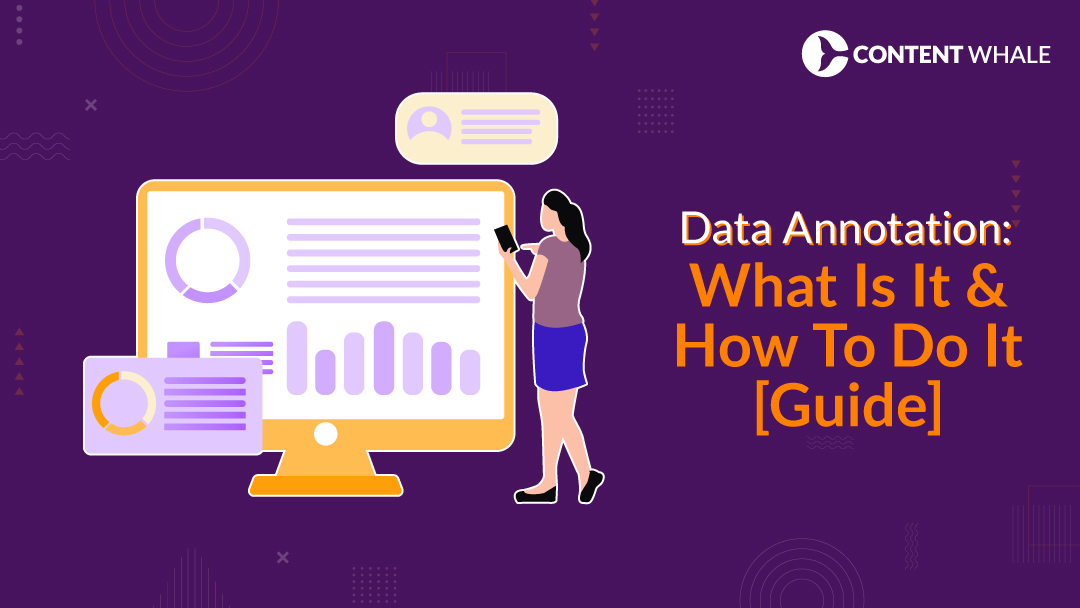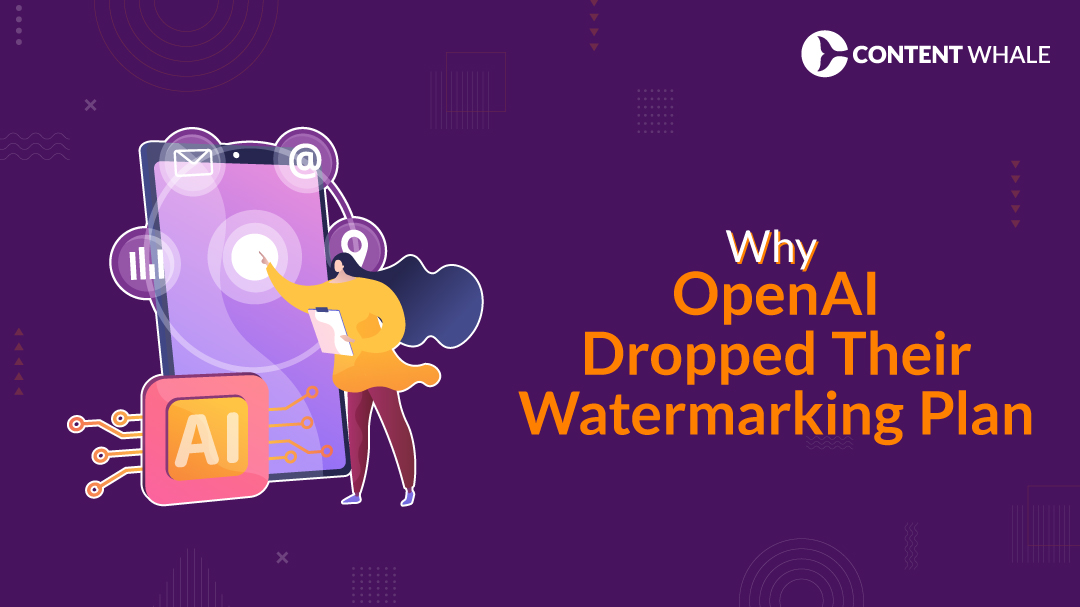Data annotation is the process of tagging and labeling raw information to make it understandable for machine learning models. Every AI product, from virtual assistants to fraud detection systems, depends on high-quality labeled data to function accurately. As AI adoption grows across sectors like healthcare, fintech, and autonomous vehicles, the demand for well-annotated data keeps rising.
What makes data annotation so important is its direct influence on model performance. A poorly annotated dataset can lead to biased, ineffective AI systems. On the other hand, clear, consistent labeling allows models to learn with fewer errors.
Teams working with AI training data now face higher expectations on accuracy, scale, and compliance. That’s exactly where Content Whale adds value by helping businesses create structured, research-backed content that simplifies complex processes like data labelling and annotation for their end audience.
This guide will walk you through the types of annotation, tools, and best practices that actually work in 2025.
1. What is Data Annotation?
Data annotation is the process of labeling raw data to help machine learning models understand it. From tagging images of cats to marking entities in text, annotation trains AI systems to recognize patterns and make decisions.
It includes text annotation, image annotation, and audio annotation, depending on the task. While data labelling is often used as a broader term, annotation involves more detailed tagging.
Both are key to supervised learning. The accuracy of any AI training data depends heavily on how precisely and consistently the data has been annotated.
Example:
A retail chatbot is trained using text annotation. Annotators tag customer queries like “Where’s my order?” as order_status and “I want to return this” as return_request. These labels help the chatbot understand user intent and respond accurately in real time.
2. Types of Data Annotation
Different AI applications need different types of data annotation based on the format and use case. Here are the most widely used types in 2025:
A) Image Annotation
Used in self-driving cars, healthcare imaging, and e-commerce. Tasks include:
- Bounding boxes: Outline objects (e.g., pedestrians, products).
- Semantic segmentation: Assign each pixel a label.
- Keypoint annotation: Mark facial landmarks or joint positions.
Example:
In an e-commerce app, annotators use bounding boxes to tag shirts, jeans, and accessories in product photos. This helps the AI suggest similar items or auto-tag listings for faster search results.
B) Text Annotation
Used in chatbots, NLP tools, and content moderation:
- Named entity recognition (NER): Tag names, dates, or locations.
- Intent classification: Identify the purpose behind a sentence.
- Sentiment tagging: Mark text as positive, negative, or neutral.
Example:
For a food delivery chatbot, sentences like “I want to cancel my order” are tagged with intent: cancellation and “Pizza Hut near me” is tagged with entity: restaurant_name. These tags improve response accuracy.
C) Audio & Video Annotation
Supports voice assistants, surveillance systems, and transcription tools:
- Speech-to-text: Convert spoken content to written format.
- Emotion labeling: Classify tone or mood in voice.
- Action tagging: Mark activities in videos for training models.
Example:
A customer support AI is trained using call recordings. Annotators use speech-to-text to transcribe calls and label emotion like frustration or satisfaction. This helps the AI route issues better or suggest actions to agents.
D) 3D & Sensor Data Annotation
Used in robotics, AR/VR, and autonomous vehicles:
- Point cloud annotation: Label LiDAR or depth sensor data.
- 3D cuboids: Surround objects in three-dimensional space for spatial understanding.
Example:
In autonomous driving, point cloud data from LiDAR sensors is annotated to identify other vehicles, pedestrians, and road signs. This allows the car to understand and respond to real-world environments accurately.
3. Manual vs. Automated Data Annotation in 2025
Choosing between manual and automated data annotation depends on your project’s goals, accuracy needs, and data complexity.
A) Manual Annotation
Human annotators tag each data point by hand. It’s slower but preferred when accuracy matters. For example, text annotation in legal or medical contexts often requires deep understanding and careful handling of sensitive content. Manual methods are ideal for small datasets or high-risk applications.
B) Automated Annotation
Pre-trained models label data automatically using algorithms and machine learning. It works well for large-scale tasks like bulk image annotation or basic sentiment tagging. While it speeds up delivery, the output often needs human review to catch errors or edge cases.
C) Hybrid Approach
Many teams use a blended method. AI tools do the first round of tagging, followed by human verification. This combination improves speed without compromising quality. It’s especially useful when building scalable AI training data pipelines where consistency and speed must co-exist.
| Annotation Type | Speed | Accuracy | Best For | Limitations |
| Manual Annotation | Slow | High | Complex tasks like legal texts, medical imaging | Time-consuming, costly at scale |
| Automated Annotation | Fast | Moderate | Large datasets, repetitive image or text tasks | May introduce errors, lacks contextual depth |
| Hybrid Annotation | Moderate | High | Scalable AI projects needing quality + speed | Requires coordination between tools & humans |
4. Steps to Perform Data Annotation
A structured approach helps avoid messy datasets and inconsistent outputs. Here’s a clear, actionable process for managing data annotation effectively in 2025.
Step 1: Define the Objective
Start by identifying what the model needs to learn. For example, if you’re building a voice assistant, decide whether you’re tagging commands, speaker emotions, or accents. This clarity shapes every other step.
Step 2: Understand the Data Format
Know whether you’re working with text annotation, image annotation, audio, or sensor data. Each type needs a different method, tool, and validation process.
Step 3: Choose the Annotation Method
Decide between manual annotation, automated annotation, or a hybrid setup based on accuracy and scale needs. For regulated sectors, manual review is usually non-negotiable.
Step 4: Select the Right Tools
Use reliable platforms like Labelbox, V7, or SuperAnnotate that support your data type and offer version control, QA, and collaboration features.
Step 5: Prepare Annotators or Configure Models
Train human annotators with clear guidelines or fine-tune your automation tools with gold-standard samples to reduce noise in output.
Step 6: Perform Quality Checks
Use consensus scoring, review cycles, or QA dashboards to catch inconsistencies. Poor quality here will affect your AI training data and the model’s long-term performance.
Step 7: Iterate and Scale
As data grows, refine your labeling strategy, expand QA coverage, and automate repeatable tagging where possible.
✅ Data Annotation Process Checklist
5. Tools and Platforms for Data Annotation
Choosing the right platform or partner can save time, improve accuracy, and help you scale your data annotation workflows effectively. In 2025, tools offer more than just labeling—they support automation, QA, collaboration, and integration into machine learning pipelines.
5.1) Content Whale: Your All-in-One Data Labeling Partner
Content Whale helps AI and data-focused companies create expert-led, research-backed content around topics like data annotation, AI training data, and machine learning data. Businesses that struggle to communicate their technical services clearly turn to Content Whale to build trust and visibility in the AI ecosystem.
5.2) Labelbox
Known for its ML-assisted features, Labelbox supports image annotation, text annotation, video tagging, and custom workflows. Ideal for fast-moving teams building AI models.
5.3) Amazon SageMaker Ground Truth
Built for scale, this AWS-native service blends human labeling with automation. It’s suited for teams handling large volumes of training data and needing consistent output.
5.4) Scale AI
A full-service annotation provider that specializes in high-precision pipelines for industries like automotive and healthcare. Great for enterprise-scale needs with tight deadlines.
5.5) V7
Popular in biomedical and scientific sectors, V7 offers AI-supported image and video annotation along with built-in model training features.
| Tool/Platform | Supported Formats | Best For | Key Features |
| Content Whale | All Formats | Scalable annotation + documentation | Human annotation + content for compliance/trust |
| Labelbox | Image, Text, Video | Agile ML teams | ML-assisted labeling, version control, integrations |
| SageMaker GT | Image, Text, Video, 3D | Enterprise use with AWS | Pre-labeling, human QA, managed infrastructure |
| Scale AI | Image, 3D, Text, LiDAR | High-volume, regulated industries | Annotation-as-a-service, secure data handling |
| V7 | Image, Video, Biomedical Data | Scientific and medical datasets | Auto-labeling, built-in model training |
Whether you’re choosing a tool or a content partner, always align the choice with your project scope, data type, and long-term goals.
6. Key Challenges in Data Annotation Projects
Even with the right tools and workflows, data annotation isn’t always smooth. Teams face several recurring issues that can affect the quality of AI training data and delay development cycles.
A) Inconsistent Labelling
When multiple annotators work on the same dataset without clear guidelines, outputs can vary. For example, one annotator might label “iPhone” as product, while another uses device. Inconsistent labels confuse models and reduce accuracy.
B) Annotator Bias
Bias creeps in when subjective tasks like sentiment tagging or image annotation rely too much on individual judgment. This can lead to skewed results, especially in sensitive domains like healthcare or HR.
C) Data Quality Issues
If your raw data is noisy, incomplete, or irrelevant, annotation becomes meaningless. Garbage in, garbage out. Always clean and validate the data before tagging begins.
D) Scalability Pressure
Manual workflows often break down under large volumes. Teams struggle to scale without automation or robust QA pipelines. This is where hybrid workflows become essential.
E) Compliance Risks
Especially in regulated industries, annotation must follow data privacy rules. Whether it’s GDPR, HIPAA, or internal compliance, failure to anonymize or restrict access can result in penalties.
Addressing these challenges early keeps your data labelling efforts accurate, consistent, and production-ready.
| Challenge | Description | Impact |
| Inconsistent Labelling | Varying labels from different annotators confuse models. | Lower model accuracy, longer debugging cycles |
| Annotator Bias | Subjective judgment leads to skewed or misleading annotations. | Biased AI outputs, unreliable predictions |
| Poor Data Quality | Noisy or irrelevant data affects annotation usefulness. | Wasted time and unusable training data |
| Scalability Issues | Manual methods break down with high-volume data. | Missed deadlines, higher operational cost |
| Compliance Risks | Mishandling sensitive data may breach regulations. | Legal penalties, trust issues, blocked model deployment |
Conclusion
Data annotation involves labeling raw data such as images, text, audio, or video to train machine learning models. But teams often face issues like inconsistent labeling, unclear guidelines, and scaling difficulties that lead to unreliable outcomes.
The consequences are serious. Poorly annotated data can break AI models, introduce bias, and lead to compliance failures that damage your brand and user trust.
That’s where Content Whale comes in. Alongside its writing and SEO capabilities, we offer professional data annotation services using trained annotators and multi-layered QA. We support image, video, text, and 3D annotations across industries.
With Content Whale, you don’t just get clean data. You get consistent results that improve real-world model performance. Let’s connect and get started today.
People also asked:
1. What common tasks does data annotation include?
Data annotation tasks include bounding boxes, segmentation, and keypoint labeling for images, NER and sentiment tagging for text annotation, and speech transcription for audio. These methods help create structured training datasets for machine learning, allowing models to recognize patterns in images, language, and sounds with greater accuracy.
2. How do I ensure consistent annotation quality?
Consistent data annotation requires detailed labeling guidelines, gold-standard examples, and peer review workflows. Use quality checks like consensus scoring and annotation validation to reduce bias. Whether using manual annotation or automated annotation, high-quality and repeatable AI training data improves model accuracy and reduces post-training debugging.
3. Why is data annotation critical for AI models?
Data annotation is essential in supervised learning because it teaches models to interpret real-world inputs. Without accurate data labelling, AI models can misclassify information, make biased decisions, or fail to generalize. Clean and consistent training datasets directly influence prediction accuracy, safety, and performance across applications like healthcare and finance.
4. How do I handle ambiguous annotation cases?
Use documented edge-case handling rules, team consensus, and expert feedback to manage unclear data annotation scenarios. Whether working on image annotation or text annotation, consistency in labeling ambiguous inputs improves AI training data reliability and avoids misinterpretation during model training or validation.
5. What formats are typical for data annotation projects?
Standard data annotation formats include bounding boxes, segmentation masks, and keypoints for images, NER and intent tagging for text annotation, and 3D point cloud or cuboid labeling for spatial data. These formats help train computer vision, NLP, and autonomous systems using structured AI training data.
6. How much data is needed for effective annotation?
The amount of data annotation required depends on model complexity. Simple tasks may need thousands of samples, while high-variance domains like autonomous driving need millions. High-quality, representative training datasets improve learning efficiency and reduce the need for retraining. Quality over quantity is key in AI training data pipelines.
7. Can automated tools replace manual annotation?
Automated annotation tools can speed up repetitive tagging but often lack contextual understanding. A hybrid workflow—automated pre-labeling with manual annotation review—offers scalability with accuracy. This method balances cost, quality, and consistency when preparing AI training data across industries like healthcare, retail, and robotics.
8. How do I prepare annotated data for compliance?
Before data annotation, anonymize personal information and apply access controls. Maintain version logs and documentation aligned with GDPR, HIPAA, or local regulations. For high-risk domains, ensure your AI training data pipeline includes audit trails and QA checkpoints to meet compliance and privacy requirements.





